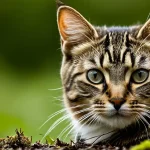Core Reasons Cats Are Attracted to Boxes
Understanding cat behavior reveals that cats are naturally drawn to boxes due to their instinctive need for hiding spaces and security. Boxes provide a safe, confined area where cats feel protected from potential threats. This enclosed space satisfies their desire to observe their surroundings discreetly, reducing stress and increasing comfort.
So, why do cats love boxes specifically? The answer lies in their deep-rooted feline instincts emphasizing both survival and predation. Boxes allow cats to mimic natural behaviors such as stalking and ambushing prey, offering an ideal hideout from which they can launch playful or hunting attacks. The tactile sensation of enclosed spaces also stimulates their hunting prowess and elevates their alertness.
In the same genre : How Can Cats Impact the Wildlife in the UK?
Cats also show a clear preference for confined and enclosed areas because these spaces regulate their body temperature, keeping them warm and cozy. The snug fit of a box triggers a calming effect, replicating the feeling of dens in the wild. These multiple factors make boxes irresistible refuges that align with a cat’s fundamental behavioral patterns.
Scientific Explanations: Biology and Psychology
Cats often seek enclosed spaces due to a combination of feline biology and the psychology of cats. From a biological standpoint, small, confined areas help cats maintain body heat. This warmth retention is crucial for thermoregulation, especially given that cats’ natural body temperature ranges between 38 and 39°C (100.4–102.2°F). Being in cozy, enclosed spaces helps them conserve energy by reducing heat loss.
In parallel : How Do Cats Show Affection to Their Owners?
Psychologically, cats experience stress reduction and comfort when inside secure, enclosed environments. Such spaces provide a retreat where they feel safe from potential threats. This behavior aligns with their instinctual need for protection and camouflage in the wild, highlighting the influence of evolutionary biology on their behavior. In natural habitats, tight spots would shield them from predators and allow for undisturbed rest.
Understanding these factors offers practical guidance: providing your cat with safe, snug hideaways can improve their wellbeing. Enclosures that mimic dens help fulfill both biological needs and psychological comfort, reflecting the deep roots of cat science in their everyday habits.
Boxes as Sources of Enrichment and Play
Engaging your cat naturally
Boxes serve as excellent tools for cat enrichment by mimicking the thrill of the hunt and encouraging natural cat play behavior. Their confined space offers a cozy hideout where cats can pounce, stalk, and explore—activities central to satisfying their hunting instincts. This stimulation taps into feline curiosity, keeping them mentally sharp and physically active.
Using boxes promotes diverse interactive cat toys experiences, even though the box itself is simple. Cats often treat boxes as tunnels or ambush points, transforming them into dynamic playgrounds. This kind of play not only entertains but also helps reduce boredom, which is a common cause of destructive or restless behaviors in indoor cats.
For instance, placing a box near window light or filling it with crinkly paper adds sensory layers to the experience, enriching the cat’s environment. Owners seeking to enhance cat enrichment can consider combining boxes with other interactive cat toys to amplify engagement and keep their cats eager to play and explore. Overall, boxes provide a low-cost, highly effective means of supporting healthy cat play behavior through enrichment.
Expert Insights and Observational Findings
Experts have long been intrigued by why cats find comfort in boxes. Expert opinions on cat behavior consistently highlight that boxes provide a sense of security and refuge for felines. According to feline research, cats are instinctively drawn to enclosed spaces to reduce anxiety and monitor their surroundings safely.
In cat studies, researchers observe that being in a box helps cats regulate stress hormones, supporting their emotional well-being. Veterinarians and animal behaviorists confirm that this enclosed space mimics natural hiding spots, helping cats feel protected. This insight is crucial for pet owners wanting to enrich their cats’ environments.
Real-life examples reinforce these findings. Many cat owners report their pets frequently seek narrow, box-like spaces, especially during unfamiliar or noisy situations. This behavior is seen as a coping strategy that promotes behavioral health and reduces fear responses.
Understanding these expert opinions on cat behavior and results from cat studies helps clarify why providing accessible boxes can enhance a cat’s daily comfort and security. This knowledge allows owners to better meet their pet’s natural needs and improve their feline’s quality of life.
Practical Advice: Boxes for Happier, Healthier Cats
Boxes are a simple yet powerful tool in cat care tips to boost your feline friend’s well-being. Choosing the right type of box is essential; sturdy cardboard boxes, wooden crates, or plastic containers with smooth edges provide safe options for home use. Avoid anything with sharp corners or toxic materials to ensure safety.
When introducing boxes to your cat, place them in quiet, familiar areas to reduce stress. Cats appreciate privacy and elevated vantage points, so stacking boxes or propping one open can encourage exploration. Gradually adding blankets or toys inside can spark curiosity without overwhelming your pet.
To further enhance improving cat well-being, consider varying box setups. Rotate boxes to keep the environment stimulating, or create obstacle courses combining boxes and tunnels. This sort of DIY enrichment engages their natural hunting instincts, promotes exercise, and reduces boredom-related behaviors.
Remember, DIY cat boxes offer a budget-friendly, effective avenue for improving mental and physical health. By carefully selecting, introducing, and rotating these spaces, you provide your cat with a comforting sanctuary that supports their overall happiness.

